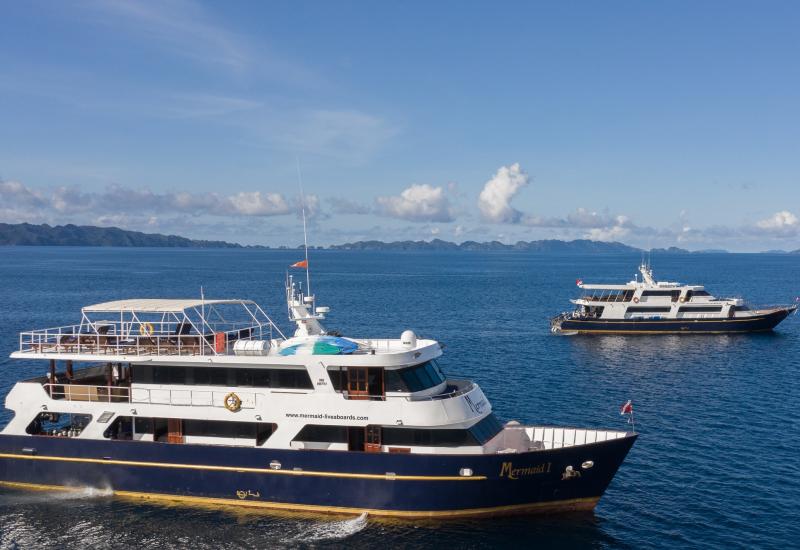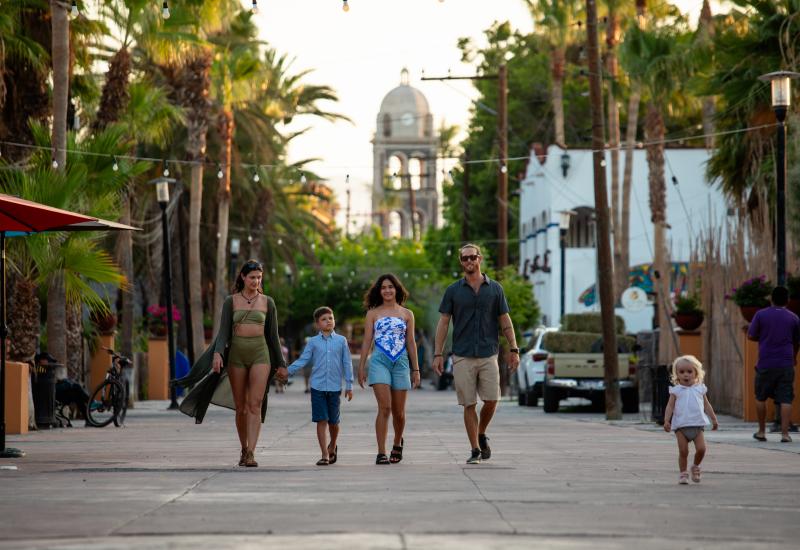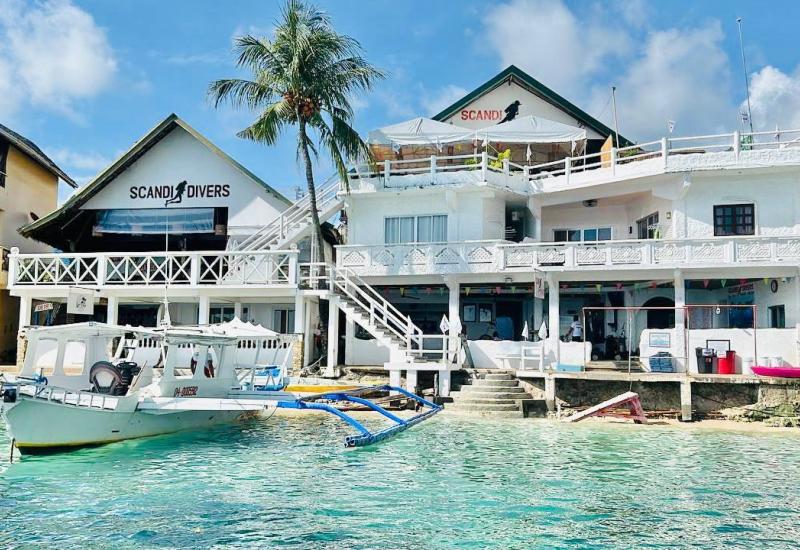Mergui Archipelago
For more than 50 years, the Mergui Archipelago, a chain of over 800 islands in the Andaman Sea, was off-limits. Since 1997, however, the isolationist government of the Republic of Myanmar (formerly Burma) has given permission to a handful of dive boats to enter these largely virgin diving waters.
What they're finding are the hallmarks of world-class live-aboard diving: sheltered anchorages, sand beaches, untouched reefs and Indo-Pacific marine creatures great and small. Divers who sign on, usually for a weeklong to 10-day cruise, immerse themselves in a marine environment unchanged by the ages.
Abundance is the operative word in these waters. Enormous schools of jacks, trevallies and tuna patrol the blue. Mantas and a host of other rays vie with the half-dozen species of sharks for divers' attention. Angelfish and batfish weave through the hard corals, lionfish flutter, clown anemonefish aggressively guard their territories. For those who think really small, there are frogfishes, ghost pipefish, harlequin shrimp, razorfish and a plethora of nudibranchs. Above the water soar brahminy kites and white-bellied sea eagles.
Getting to Mergui
Dive trips depart from either Phuket or Ranong, both in Thailand. Itineraries beginning at the popular resort island of Phuket may include such superlative Thai diving destinations as the Similan and Surin islands, and Richelieu Rock, which offers some of the most consistent whale shark encounters in the world. Charters that depart from Ranong, on the Thailand-Myanmar border, maximize time spent in the less-frequented locations farther north, including the Mergui Archipelago.
Diving the Mergui Archipelago
Because the island chain spreads out over more than 10,000 square miles, it is not surprising to find a vast variety of underwater landscapes, including submerged pinnacles and seamounts, limestone caves, sheer and sloping rock walls, and boulder-strewn sand bottoms. Sharks are so numerous that it is rare not to see them on a dive. The smorgasbord of vibrant corals and diverse, healthy fish populations make it nearly impossible to turn down any of the four daily dives the live-aboards typically offer.
Sea Gypsies
The diver in Burma is far more likely to run into a shark than another human being. The only human inhabitants of the area are Moken sea gypsies, an indigenous people whose nomadic seafaring ways are little changed from antiquity. The sea gypsies are subsistence fishermen and take only what they need from the sea, leaving a vigorous, naturally balanced ecosystem.
Top Burmese Dives
Many of the dive boat operators conduct reconnaissance missions to check out new locations, so additional dive sites are being discovered every year. Some of the best, at least at the moment, include:
Western Rocky. Fifty miles offshore, Western Rocky is one of the southernmost dive sites in Burmese waters. On one side, a sloping wall descends to a sandy bottom at 100 feet that is filled with colorful soft corals and large sea fans and frequented by cuttlefish. The other sides feature classic wall diving. Western Rocky's most stunning element is a large tunnel that runs through the island and is populated by sleeping nurse sharks and dozens of lobsters.
North and South Twin. Several dive sites at the submerged reefs off these islands feature large granite boulders in about 60 feet of water, covered with elkhorn and staghorn coral sheltering a whole range of reef fish. Large schools of jacks and trevallies work the area, which also attracts more than its share of barracuda and white tips.
Burma Banks. These submerged sea-mounts rise from the 1,000-foot-deep ocean floor to coral-covered flat tops within 50 feet of the surface. The remoteness of this westernmost area ensures large populations of a host of pelagics, particularly large, toothy silvertips. The reefs are not spectacular, but the Burma Banks is known as one of the world's best shark diving locales.
Black Rock. This stark, vegetationless rock sticking out of the ocean could be called the merry-go-round. Just large enough to circumnavigate in a leisurely dive, one side has a steep drop to 100 feet, the other a series of ledges and boulder fields. Leopard sharks cruise gracefully around Black Rock while clouds of baitfish stack up so thick a diver can get lost inside. Schools of jacks, tuna and mackerel flow by in an endless river. The macro picture is also bountiful, with scorpionfish galore, peppered and green morays, tiny crabs and harlequin shrimp. Black Rock also offers perfect specimens of cowrie, scallop, murex and top shells. Truly a world-class dive.
Several dive sites have been explored north of Black Rock, leading to the waters west of the town of Mergui, once an important stopover for caravans crossing the narrow strip of land between the Andaman Sea and the South China Sea. Potential exists for land-based dive businesses to operate out of Mergui, but none have opened their doors yet. If they do in the future, divers will have greater access to the hospitable Burmese people with their rich Buddhist culture. Until then, a land-based tour is the perfect complement to a week on a live-aboard.
Dive In: Mergui Archipelago
Getting There: Phuket, Thailand, has an international airport and is easily reached from Bangkok, Singapore and a host of other cities. Live-aboards that depart from Ranong usually arrange bus or air transportation from Phuket.
Entry Requirements: Americans who visit Thailand are granted a 30-day visa upon entry. A $100 to $160 port fee is collected on the Burmese border, to be paid in crisp, new American dollars. Travelers should bring these bills from home, as U.S. currency cannot be obtained in Thai banks. No special visa is required for those who cruise Burmese waters, but for land-based visits a special visa must be obtained in advance.
Water conditions: Water temperatures average 80 to 85 degrees year-round. A skin or light wetsuit is recommended, both because of the daily three- to four-dive schedule, and to guard against jellyfish stings. Visibility ranges from as low as 30 feet near the mainland to more than 150 feet around the islands farther offshore. Currents vary from nonexistent to quite strong, leaving the choice of whether to conduct drift dives or anchored dives to the divemaster's discretion.
Climate: The climate in Burma is typically monsoonal, with rainy, hot and humid summers and milder, drier winters, with temperatures averaging in the high 80Fs. Most dive operators book during the dry season, from November through May, when winds tend to be light and seas calm, although squalls can develop at any time.
Health: The water on live-aboards is purified and safe to drink. The food is usually a mixture of Asian cuisine that is a dream come true for lovers of spicy food, with choices available for those with a less adventurous palate.
Just in case: There is a hyperbaric chamber in Phuket. It can, however, be a long haul from Burmese waters. Divemasters preach safety--and rightly so.
For more than 50 years, the Mergui Archipelago, a chain of over 800 islands in the Andaman Sea, was off-limits. Since 1997, however, the isolationist government of the Republic of Myanmar (formerly Burma) has given permission to a handful of dive boats to enter these largely virgin diving waters.
What they're finding are the hallmarks of world-class live-aboard diving: sheltered anchorages, sand beaches, untouched reefs and Indo-Pacific marine creatures great and small. Divers who sign on, usually for a weeklong to 10-day cruise, immerse themselves in a marine environment unchanged by the ages.
Abundance is the operative word in these waters. Enormous schools of jacks, trevallies and tuna patrol the blue. Mantas and a host of other rays vie with the half-dozen species of sharks for divers' attention. Angelfish and batfish weave through the hard corals, lionfish flutter, clown anemonefish aggressively guard their territories. For those who think really small, there are frogfishes, ghost pipefish, harlequin shrimp, razorfish and a plethora of nudibranchs. Above the water soar brahminy kites and white-bellied sea eagles.
Getting to Mergui
Dive trips depart from either Phuket or Ranong, both in Thailand. Itineraries beginning at the popular resort island of Phuket may include such superlative Thai diving destinations as the Similan and Surin islands, and Richelieu Rock, which offers some of the most consistent whale shark encounters in the world. Charters that depart from Ranong, on the Thailand-Myanmar border, maximize time spent in the less-frequented locations farther north, including the Mergui Archipelago.
Diving the Mergui Archipelago
Because the island chain spreads out over more than 10,000 square miles, it is not surprising to find a vast variety of underwater landscapes, including submerged pinnacles and seamounts, limestone caves, sheer and sloping rock walls, and boulder-strewn sand bottoms. Sharks are so numerous that it is rare not to see them on a dive. The smorgasbord of vibrant corals and diverse, healthy fish populations make it nearly impossible to turn down any of the four daily dives the live-aboards typically offer.
Sea Gypsies
The diver in Burma is far more likely to run into a shark than another human being. The only human inhabitants of the area are Moken sea gypsies, an indigenous people whose nomadic seafaring ways are little changed from antiquity. The sea gypsies are subsistence fishermen and take only what they need from the sea, leaving a vigorous, naturally balanced ecosystem.
Top Burmese Dives
Many of the dive boat operators conduct reconnaissance missions to check out new locations, so additional dive sites are being discovered every year. Some of the best, at least at the moment, include:
Western Rocky. Fifty miles offshore, Western Rocky is one of the southernmost dive sites in Burmese waters. On one side, a sloping wall descends to a sandy bottom at 100 feet that is filled with colorful soft corals and large sea fans and frequented by cuttlefish. The other sides feature classic wall diving. Western Rocky's most stunning element is a large tunnel that runs through the island and is populated by sleeping nurse sharks and dozens of lobsters.
North and South Twin. Several dive sites at the submerged reefs off these islands feature large granite boulders in about 60 feet of water, covered with elkhorn and staghorn coral sheltering a whole range of reef fish. Large schools of jacks and trevallies work the area, which also attracts more than its share of barracuda and white tips.
Burma Banks. These submerged sea-mounts rise from the 1,000-foot-deep ocean floor to coral-covered flat tops within 50 feet of the surface. The remoteness of this westernmost area ensures large populations of a host of pelagics, particularly large, toothy silvertips. The reefs are not spectacular, but the Burma Banks is known as one of the world's best shark diving locales.
Black Rock. This stark, vegetationless rock sticking out of the ocean could be called the merry-go-round. Just large enough to circumnavigate in a leisurely dive, one side has a steep drop to 100 feet, the other a series of ledges and boulder fields. Leopard sharks cruise gracefully around Black Rock while clouds of baitfish stack up so thick a diver can get lost inside. Schools of jacks, tuna and mackerel flow by in an endless river. The macro picture is also bountiful, with scorpionfish galore, peppered and green morays, tiny crabs and harlequin shrimp. Black Rock also offers perfect specimens of cowrie, scallop, murex and top shells. Truly a world-class dive.
Several dive sites have been explored north of Black Rock, leading to the waters west of the town of Mergui, once an important stopover for caravans crossing the narrow strip of land between the Andaman Sea and the South China Sea. Potential exists for land-based dive businesses to operate out of Mergui, but none have opened their doors yet. If they do in the future, divers will have greater access to the hospitable Burmese people with their rich Buddhist culture. Until then, a land-based tour is the perfect complement to a week on a live-aboard.
Dive In: Mergui Archipelago
Getting There: Phuket, Thailand, has an international airport and is easily reached from Bangkok, Singapore and a host of other cities. Live-aboards that depart from Ranong usually arrange bus or air transportation from Phuket.
Entry Requirements: Americans who visit Thailand are granted a 30-day visa upon entry. A $100 to $160 port fee is collected on the Burmese border, to be paid in crisp, new American dollars. Travelers should bring these bills from home, as U.S. currency cannot be obtained in Thai banks. No special visa is required for those who cruise Burmese waters, but for land-based visits a special visa must be obtained in advance.
Water conditions: Water temperatures average 80 to 85 degrees year-round. A skin or light wetsuit is recommended, both because of the daily three- to four-dive schedule, and to guard against jellyfish stings. Visibility ranges from as low as 30 feet near the mainland to more than 150 feet around the islands farther offshore. Currents vary from nonexistent to quite strong, leaving the choice of whether to conduct drift dives or anchored dives to the divemaster's discretion.
Climate: The climate in Burma is typically monsoonal, with rainy, hot and humid summers and milder, drier winters, with temperatures averaging in the high 80Fs. Most dive operators book during the dry season, from November through May, when winds tend to be light and seas calm, although squalls can develop at any time.
Health: The water on live-aboards is purified and safe to drink. The food is usually a mixture of Asian cuisine that is a dream come true for lovers of spicy food, with choices available for those with a less adventurous palate.
Just in case: There is a hyperbaric chamber in Phuket. It can, however, be a long haul from Burmese waters. Divemasters preach safety--and rightly so.










